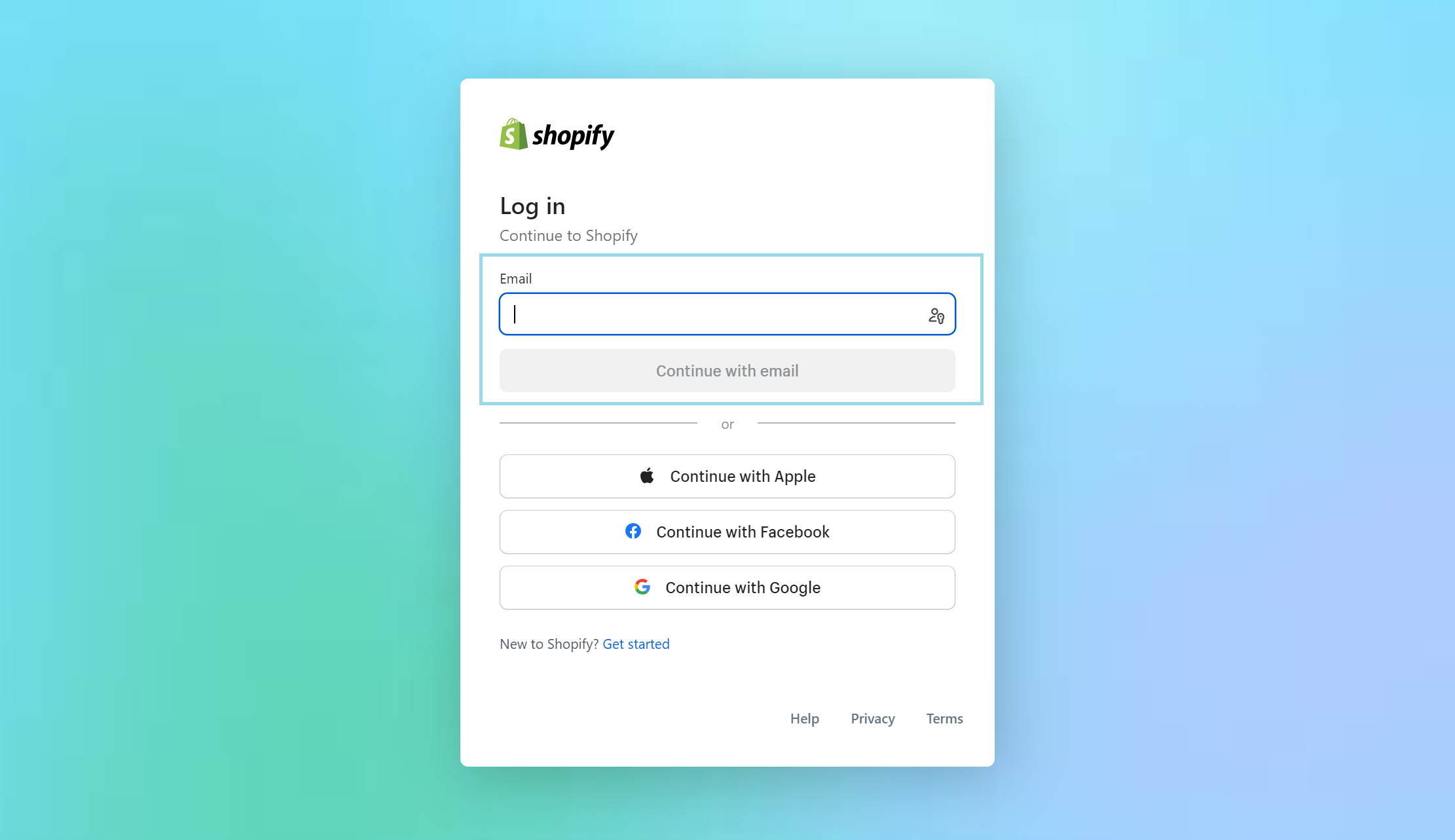Logging into Shopify is the first step to managing your online store. It’s a simple process but crucial for accessing all your tools and settings.
Understanding how to navigate the Shopify login page can save you time and frustration. Whether you’re a new user or a seasoned pro, knowing the ins and outs of the login process can streamline your experience. We’ll cover everything you need to know about logging into Shopify, from basic steps to troubleshooting common issues.
By the end of this guide, you’ll feel confident and ready to dive into your online business. Let’s get started on making your Shopify login smooth and hassle-free.
Introduction To Shopify Login
Welcome to the world of Shopify! Understanding the Shopify login process is essential. This platform allows users to create, manage, and grow their online stores. Let’s explore what makes Shopify Login so important and user-friendly.
Importance Of Secure Access
Security is crucial for any online platform. Shopify ensures your data stays safe. Its login process uses advanced encryption. This protects your personal and business information. Secure access prevents unauthorized logins. It keeps your store and customer data safe.
User-friendly Interface
Shopify’s login interface is simple and intuitive. Users can easily navigate the login process. Even beginners find it easy to use. The design is clean and straightforward. This reduces confusion and speeds up the login process. It helps you focus on running your online store efficiently.
Creating A Shopify Account
Creating a Shopify account is the first step to starting your online store. This process is simple and user-friendly. Follow these steps to get started with Shopify.
Sign-up Process
Visit the Shopify website and click on the “Get Started” button. Enter your email address, create a password, and choose a store name. Click “Create Your Store” to begin. Shopify will guide you through the initial setup.
Setting Up Your Profile
After creating your store, complete your profile. Fill in your personal details, such as your name, address, and contact information. Make sure everything is accurate. This information is important for your store’s credibility.
Next, customize your store settings. Choose your preferred language and currency. Set up your billing information. This ensures smooth transactions and payments. Finally, add your business information. Provide a brief description of your store and what you sell. This helps customers understand your brand.
Login Methods
Shopify offers various login methods to ensure secure access to your store. Each method provides different levels of security and ease of use.
Email And Password Login
The most common login method for Shopify is using email and password. Users enter their registered email address and secure password. It’s simple and effective. Choose a strong password for better security. Regularly updating your password is recommended.
Two-factor Authentication
Two-Factor Authentication (2FA) adds an extra layer of security. After entering your password, you receive a verification code on your phone or email. Enter this code to access your account. 2FA makes it harder for unauthorized users to access your account. It’s a great way to keep your store safe.
Password Management
Managing your password is crucial for securing your Shopify account. A strong password helps protect your store and customer data. This section will guide you on how to reset your password and best practices for creating strong passwords.
Resetting Your Password
If you forget your password, resetting it is simple. Follow these steps:
- Go to the Shopify login page.
- Click on Forgot password?
- Enter your registered email address.
- Check your email for a password reset link.
- Click the link and follow the instructions to create a new password.
Ensure you check your spam folder if you do not see the reset email in your inbox.
Best Practices For Passwords
Having a strong password is key to protecting your account. Here are some best practices:
- Use a mix of uppercase, lowercase, numbers, and special characters.
- Avoid using easily guessable information like birthdays or common words.
- Change your password regularly to enhance security.
- Do not reuse passwords from other accounts.
- Consider using a password manager to generate and store passwords safely.
By following these tips, you can create strong passwords that help keep your Shopify account secure.
Troubleshooting Login Issues
Having trouble logging into your Shopify account? Don’t worry, you’re not alone. Many users face login issues from time to time. This section will help you understand common problems and how to fix them.
Common Login Problems
Some common issues users face include:
- Incorrect Email or Password: Ensure you enter the correct email and password.
- Browser Issues: Your browser might be outdated or have a cache problem.
- Two-Factor Authentication: You might need to verify your identity.
- Account Lockout: Too many failed attempts can lock your account temporarily.
Check these points to resolve your login issues:
- Double-check your email and password.
- Clear your browser cache or use a different browser.
- Ensure your two-factor authentication is set up correctly.
- Wait a few minutes if your account is locked, and try again.
Contacting Support
If you still can’t log in, contact Shopify support for help. They offer various ways to reach them:
| Support Option | Details |
|---|---|
| Email Support | Send an email to support@shopify.com |
| Live Chat | Available 24/7 on the Shopify website |
| Phone Support | Call their support number for immediate help |
Ensure you have your account details ready. This helps support resolve your issue quickly.
Integrating Social Media
Integrating social media with your Shopify store can streamline the login process for your customers. By allowing users to log in using their social media accounts, you can enhance user experience and potentially increase sign-ups. This section will explain how to integrate Facebook Login and Google Login with your Shopify store.
Facebook Login
Enabling Facebook Login allows users to access your Shopify store with their Facebook credentials. This process simplifies the login experience and can lead to higher user engagement.
Here are the steps to integrate Facebook Login:
- Go to your Shopify Admin panel.
- Navigate to Online Store > Preferences.
- Scroll down to the Customer Accounts section.
- Select Enable Facebook Login.
- Follow the on-screen instructions to complete the setup.
Once integrated, users can log in quickly, improving their overall shopping experience.
Google Login
Google Login is another popular option for simplifying user authentication. Many customers have Google accounts, making this a convenient login method.
To add Google Login:
- Access your Shopify Admin dashboard.
- Click on Online Store > Preferences.
- Scroll to the Customer Accounts section.
- Choose Enable Google Login.
- Complete the setup as per the instructions provided.
With Google Login, users can log in with their Google credentials, which enhances their shopping experience and reduces cart abandonment.
Mobile Access
Mobile access to Shopify is essential for store owners on the go. Whether you want to manage orders, check inventory, or update products, accessing Shopify from your mobile device ensures you stay connected. This section explores the different ways to log in to Shopify using your mobile device.
Logging In Via Mobile App
Shopify offers a dedicated mobile app for both iOS and Android users. This app provides an intuitive interface for store management. Download the Shopify app from the App Store or Google Play. Open the app, then enter your store’s domain, email, and password. Once logged in, you can manage your store effortlessly. The app is designed for ease of use and quick access to essential features.
Mobile Browser Access
You can also log in to Shopify through your mobile browser. Open your preferred browser and go to the Shopify login page. Enter your store’s URL, email, and password. The mobile site is optimized for smaller screens. This makes it easy to navigate and perform key tasks. Whether you use Chrome, Safari, or another browser, Shopify ensures a smooth experience.
Security Measures
Security measures are crucial when accessing your Shopify account. Protecting your store data is essential to prevent unauthorized access and potential breaches. This section will guide you through recognizing phishing attempts and securing your account effectively.
Recognizing Phishing Attempts
Phishing attempts can trick you into giving away your login details. Always check the sender’s email address for legitimacy. Look for spelling errors or unusual URLs in the email. Be cautious of any urgent messages asking for sensitive information.
Do not click on suspicious links. Instead, go directly to the official Shopify website. Use the official Shopify app for secure access. Report any suspicious emails to Shopify immediately.
Securing Your Account
Use a strong and unique password for your Shopify account. Avoid using common words or easily guessable information. Enable two-factor authentication (2FA) for an added layer of security.
Keep your software and devices up-to-date. Regularly review your account activity for any unusual logins. Revoke access for any unfamiliar devices or applications. Educate your team about security practices to ensure everyone is aware of potential threats.
Admin And Staff Accounts
Managing a Shopify store can be a team effort. Admin and staff accounts allow you to share responsibilities. This ensures smooth operations and better efficiency. Admin accounts have complete control over the store. Staff accounts have limited access based on their roles. Properly managing these accounts is crucial for security and workflow.
Creating Staff Accounts
To create a staff account, log in to your Shopify admin. Navigate to Settings and then click on Users and Permissions. Click on Add Staff Account. Enter the staff member’s details and set their permissions. Click Send Invite. The staff member will receive an email. They can then set up their account and log in.
Managing Permissions
Permissions determine what staff can access and do. To manage permissions, go to Users and Permissions. Select the staff member whose permissions you want to change. You will see a list of permissions you can enable or disable. Select the appropriate permissions based on their role. Save the changes to apply the new permissions.
Regularly review and update permissions. This ensures staff only access what they need. It helps maintain security and streamline operations.

Credit: www.reconvert.io
Third-party App Integration
Shopify makes it easy to integrate third-party apps. These apps enhance your store’s functionality. They provide additional features and tools. This section will guide you through using third-party apps for Shopify Login.
Login With Third-party Apps
Many stores use third-party apps for login options. These apps simplify the login process for customers. Popular choices include Google, Facebook, and Apple. They allow customers to log in using their existing accounts. This saves time and improves the user experience. Ensure the app you choose is reliable and secure.
Managing App Permissions
Managing app permissions is crucial for security. Granting the right permissions ensures your store’s safety. Only allow necessary permissions to third-party apps. Regularly review and update permissions as needed. This helps prevent unauthorized access and protects customer data. Always prioritize security when dealing with third-party apps.
Single Sign-on (sso)
Single Sign-On (SSO) is a method that allows users to log in once and gain access to multiple applications. This simplifies the login process and enhances security. In the context of Shopify, SSO can streamline user access across various platforms. Let’s explore the benefits and setup process of SSO for Shopify.
Benefits Of Sso
Implementing SSO on Shopify offers several advantages:
- Enhanced User Experience: Users log in once and access all linked applications without repeated logins.
- Improved Security: Reduces password fatigue. Users manage fewer passwords, lowering the risk of weak passwords.
- Centralized Control: Administrators manage user access and credentials from a single point, enhancing control and oversight.
- Increased Productivity: Users save time as they don’t need to repeatedly log in to multiple systems.
Setting Up Sso
Follow these steps to set up SSO for your Shopify store:
- Choose an SSO Provider: Select a provider that integrates with Shopify. Popular options include Okta, OneLogin, and Auth0.
- Configure the Identity Provider: Set up your chosen SSO provider with your Shopify store. This will involve creating an application in the SSO provider’s dashboard.
- Update Shopify Settings: In Shopify, navigate to the admin settings and configure the SSO settings. Enter the required information from your SSO provider.
- Test the Integration: Ensure the SSO setup is working correctly by testing with a few user accounts.
- Roll Out to Users: Once tested, enable SSO for all users. Provide guidance on how to use the new login method.
Setting up SSO can streamline the login process and improve security for your Shopify store. Following the steps above can help you easily integrate SSO and enjoy its benefits.

Credit: help.shopify.com
Session Management
Session management is crucial for a smooth Shopify experience. It ensures user security and seamless shopping. Proper session handling prevents unauthorized access and keeps your data safe.
Session Timeout Settings
Shopify provides default session timeout settings. These settings automatically log out users after a period of inactivity. This feature protects your store from unauthorized access. You can adjust the timeout duration to fit your needs.
| Inactivity Duration | Action |
|---|---|
| 15 minutes | Default Logout |
| 30 minutes | Optional Setting |
| 1 hour | Optional Setting |
Adjusting these settings is simple. Follow these steps:
- Go to your Shopify Admin panel.
- Click on Settings.
- Select Security.
- Find the Session Timeout section.
- Choose your preferred timeout duration.
Extending Session Duration
Sometimes, you need longer sessions. Extending session duration helps during extensive tasks. To extend your session duration, follow these steps:
- Go to your Shopify Admin panel.
- Click on Settings.
- Select Security.
- Find the Session Timeout section.
- Choose a longer timeout duration, such as 1 hour.
Extending session duration is useful. It enhances user experience during long tasks. Always balance security and convenience when setting duration.
Login Analytics
Understanding login analytics is vital for any Shopify store owner. Tracking and analyzing login data helps improve security and user experience. This section will delve into the essential aspects of login analytics.
Tracking Login Activity
Tracking login activity provides valuable insights into user behavior. It helps identify patterns and potential security threats. Here are key points to track:
- Login Time: Knowing when users log in helps detect unusual activity.
- IP Address: Monitoring IP addresses helps identify suspicious logins.
- Device Information: Tracking device types helps understand how users access your store.
- Failed Login Attempts: High rates of failed attempts may indicate a security threat.
Analyzing Login Data
Analyzing login data helps improve your Shopify store’s performance. It provides insights into user behavior and security. Here are some analytical methods:
- Trend Analysis: Identify trends in login times and locations.
- Behavioral Insights: Understand how frequently users log in and their device preferences.
- Security Analysis: Detect patterns in failed login attempts to enhance security measures.
Using these analytics, you can make informed decisions. This can lead to improved security and a better user experience.

Credit: litextension.com
Customizing Login Page
Making a unique and personalized login page can significantly enhance your brand’s identity on Shopify. This section will guide you through customizing your login page, including adding your brand elements and custom fields.
Branding Your Login Page
Your login page is often the first impression customers have of your store. Branding it effectively is crucial. Here are some steps to help you brand your login page:
- Add your logo: A logo on the login page reinforces your brand identity. Use the Shopify admin panel to upload your logo.
- Choose a color scheme: Select colors that match your brand. Customize the background, buttons, and text to reflect your brand colors.
- Use custom fonts: Fonts are another way to express your brand. Shopify allows you to use custom fonts for a consistent look.
Here’s a simple example of how to add a logo using HTML:

Adding Custom Fields
Custom fields can collect more information from users during login. This can enhance user experience and gather valuable data.
To add custom fields:
- Navigate to the Shopify admin panel.
- Select “Online Store” and then “Themes.”
- Click “Actions” and select “Edit code.”
- Locate the login template file and add your custom fields.
Here is an example of a custom field for phone numbers:
Adding these fields helps in segmenting your customers better. It can also provide a personalized shopping experience.
| Field | Purpose |
|---|---|
| Primary contact method | |
| Phone | Secondary contact method |
| Address | Shipping information |
With these steps, your Shopify login page will not only look professional but also provide valuable information.
Future Of Shopify Login
The future of Shopify Login is bright with innovative changes on the horizon. As online shopping evolves, so do the ways users access their Shopify accounts. This ensures a smooth and secure experience for all. Let’s explore the upcoming features and predicted trends shaping the future of Shopify Login.
Upcoming Features
Shopify plans to introduce multi-factor authentication for enhanced security. This will add an extra layer of protection to user accounts. Another anticipated feature is single sign-on (SSO). SSO allows users to log in using one set of credentials across multiple platforms. This simplifies the login process and saves time. Additionally, biometric login options such as fingerprint and facial recognition are expected. These features will offer faster and more secure access to accounts. Shopify is also working on integrating passwordless login. This will use magic links or temporary codes sent to users’ emails or phones. It will reduce the risk of password-related security issues.
Predicted Trends
Personalization will be a key trend in the future of Shopify Login. Users may see login screens tailored to their preferences and behavior. This makes the experience more engaging and user-friendly. Another trend is the increased use of artificial intelligence. AI will help detect and prevent unauthorized login attempts. It will analyze patterns and flag suspicious activities. The rise of mobile commerce will drive the need for mobile-first login solutions. These solutions will ensure that logging in on mobile devices is seamless and efficient. Privacy and data protection will continue to be a major focus. Users will demand more transparency about how their login data is used and stored. Lastly, we can expect continuous improvement in user experience design. This will make the login process even more intuitive and accessible.
Frequently Asked Questions
How Do I Log Into Shopify?
To log into Shopify, visit the Shopify login page. Enter your email and password. Click ‘Log in’. You will be redirected to your Shopify dashboard.
What If I Forget My Shopify Password?
If you forget your password, click ‘Forgot password? ‘ On the login page. Enter your email. Follow the instructions sent to your email to reset your password.
Can I Log Into Shopify On Mobile?
Yes, you can log into Shopify on mobile. Download the Shopify app from the App Store or Google Play. Open the app and enter your login credentials.
How Do I Secure My Shopify Login?
To secure your Shopify login, enable two-factor authentication. Go to your account settings. Follow the steps to set up two-factor authentication. This adds an extra layer of security.
Conclusion
Accessing your Shopify account is simple and efficient. The login process ensures your store’s security. Always remember to keep your credentials safe. Regularly update your password for added protection. Explore Shopify’s features to improve your online store. A smooth login experience helps manage your business better.
Stay connected and manage your store effortlessly. Happy selling!








